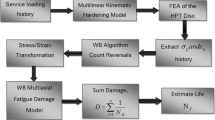Abstract
Creep behavior is one of the most critical factors determining the failure life of components at elevated temperature. Turbine rotor shaft is subjected to such elevated conditions. The creep behavior of rotor grade steel 28CrNiMoV59 was studied at elevated temperatures from 550 to 650 °C and at stress levels varying from 120 to 300 MPa. Tensile tests were conducted to determine the basic properties. Microstructural and chemical analyses were performed to characterize the as received material. Creep rupture data were determined from experimental results. These results were used to calculate the creep constants at elevated temperature which are used in time–temperature parametric (TTP) methods. Different TTP methods like, Larson–Miller, Orr–Sherby–Dorn and Manson–Haferd, were analyzed to check their suitability for extrapolation of creep rupture data of (28CrNiMoV59) steel.







Similar content being viewed by others
References
Dieter G E, in Mechanical Metallurgy, (ed) Michael B B, McGraw-Hill Book Company, London (1988).
Maruyama K, Lee J S and Shibli I A, Creep and Fracture in High Temperature Components—Design and Life Assessment Issues, DEStech Publications, Lancaster (2005).
Viswanathan R, Damage Mechanisms and Life Assessment of High Temperature Components, (ed) ASM International, Metals Park (1989).
Whittaker M T and Wilshire B, Mater Sci Eng A 527 (2010) 4932.
Kim W G, Met Mater Int 15 (2009) 559.
Larson F R and Miller J, ASME 74 (1952) 765.
Dorn J E, Some Fundamental Experiments on High Temperature Creep, University of California, Berkeley (1955).
Manson S S and Haferd A M, A Linear Time-Temperature Relation for Extrapolation of Creep and Stress Rupture Data, NACA TN 2890, Lewis Flight Propulsion Laboratory, Cleveland, Ohio (1953).
Wilshire B and Scharning P J, Int J Press Vessels Pip 85 (2008) 739.
Acknowledgments
The authors would like to express sincere gratitude towards Mr. Shreyas Kirwai and Mr. Santosh Kumar for their continuous support and valuable comments. The authors gratefully acknowledge the extended support provided to this work by KCTI (Kalyani Centre for Technology and Innovation) for providing financial funding, laboratory and library facilities. The authors also acknowledge the support provided by Bharat Forge Ltd, Pune and DSIR (Department of Scientific and Industrial Research), Govt. of India. Finally, the authors would like to express special thanks and gratitude to review committee and top management of Bharat Forge Ltd for granting the permission to publish/present the research work.
Author information
Authors and Affiliations
Corresponding author
Rights and permissions
About this article
Cite this article
Mehta, M.I., Kashyap, B.P., Singh, R.K.P. et al. Estimation of Creep Failure Life of Rotor Grade Steel by Using Time–Temperature Parametric Methods. Trans Indian Inst Met 69, 591–595 (2016). https://doi.org/10.1007/s12666-015-0755-x
Received:
Accepted:
Published:
Issue Date:
DOI: https://doi.org/10.1007/s12666-015-0755-x




